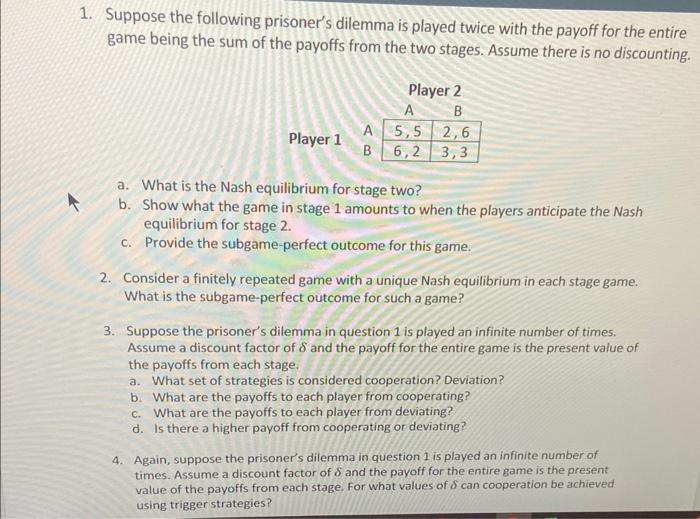Answered step by step
Verified Expert Solution
Question
1 Approved Answer
1. Suppose the following prisoner's dilemma is played twice with the payoff for the entire game being the sum of the payoffs from the

1. Suppose the following prisoner's dilemma is played twice with the payoff for the entire game being the sum of the payoffs from the two stages. Assume there is no discounting. Player 1 A B Player 2 B A 5,5 2,6 6,2 3,3 a. What is the Nash equilibrium for stage two? b. Show what the game in stage 1 amounts to when the players anticipate the Nash equilibrium for stage 2. c. Provide the subgame-perfect outcome for this game. 2. Consider a finitely repeated game with a unique Nash equilibrium in each stage game. What is the subgame-perfect outcome for such a game? 3. Suppose the prisoner's dilemma in question 1 is played an infinite number of times. Assume a discount factor of & and the payoff for the entire game is the present value of the payoffs from each stage. a. What set of strategies is considered cooperation? Deviation? b. What are the payoffs to each player from cooperating? c. What are the payoffs to each player from deviating? d. Is there a higher payoff from cooperating or deviating? 4. Again, suppose the prisoner's dilemma in question 1 is played an infinite number of times. Assume a discount factor of & and the payoff for the entire game is the present value of the payoffs from each stage. For what values of & can cooperation be achieved using trigger strategies?
Step by Step Solution
★★★★★
3.43 Rating (162 Votes )
There are 3 Steps involved in it
Step: 1
ANSWER 1 a In stage 2 both players have a dominant strategy of choosing A resulting in a Nash equili...
Get Instant Access to Expert-Tailored Solutions
See step-by-step solutions with expert insights and AI powered tools for academic success
Step: 2

Step: 3

Ace Your Homework with AI
Get the answers you need in no time with our AI-driven, step-by-step assistance
Get Started


